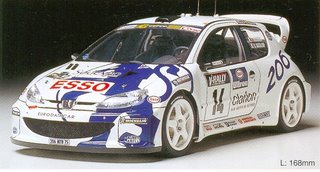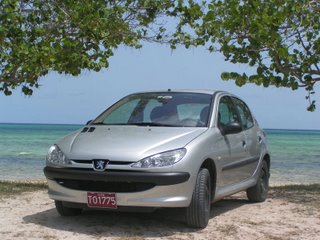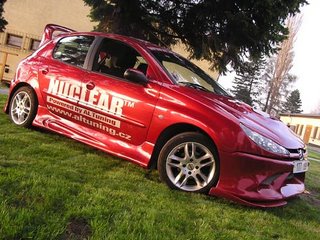







The Peugeot 206 is a supermini manufactured by the French automaker Peugeot since 1998.
During the early to mid-1990s Peugeot decided not to directly replace the iconic Peugeot 205, citing the reason that superminis were no longer profitable or worthwhile. Instead, Peugeot followed a unique strategy and decided that its new, much smaller, supermini, the Peugeot 106 launched in 1991, would take sales from the lower end of the 205 range while the lowlier models of the Peugeot 306 range, launched in 1993 to replace the Peugeot 309, would take sales from the top-end 205s. Between the 106 and 306 Peugeot hoped that the 205 would not need to be replaced, and could be phased out slowly, while customers who would normally plump for the 205 would continue to have a choice with either a smaller or larger car.
Unfortunately for Peugeot, this strategy did not work. With the 205 phased out, sales of rivals' superminis continued to sell well and even increased, and without a direct competitor to these rivals Peugeot was losing sales fast. A new supermini was required, and the 206 was launched in 1998 as a somewhat belated replacement for the 205.
Although the 206 moniker indicates a direct continuation from the 205, some critics state that the car should have instead been badged 207. This is because Peugeot launched its latest generation of cars in the early to mid 1990s, with the 106 of 1991, the 306 of 1993 and the 406 of 1995.With no larger in-house rival from Citroën to base its new supermini on (the Citroën Saxo shared its platform with the 106), Peugeot developed an all-new front drive platform for the 206.The 206 was originally launched as a hatchback with 1.1 L, 1.4 L and 1.6 L petrol engines and a 1.9 L diesel engine, a HDi version with common rail coming later. In 1999 a 2.0 L GTI capable of 210 km/h, and in 2003 a tuned version of the GTI called the Peugeot 206 RC (GTI 180 in the UK), were added to the range. It did 0-100 km/h (0-62 mph) in 7.5s and it reached a top speed of 220 km/h (137 mph) with 180 bhp (130 kW). In 2001, two more versions of the 206 were launched - the 206cc (Coupé Cabriolet) with a folding steel roof and the 206 SW station wagon. A 4-door sedan version was unveiled in late 2005, and it is available in the North African, Chinese, Russian and Iranian markets.
The 206 is mainly manufactured in Peugeot's Poissy and Mulhouse factories although the car is also produced by Iran Khodro in Iran for that market, although Iran's model will reportedly be exported as well.[1] It was assembled in Chile for the Mexican and Colombian markets (French made 206s were cheaper than Chilean-built ones, in Chile). The Brazilian production in Porto Real, Rio de Janeiro, started in 2001, followed by the SW version in 2005. The Brazilian production features 1.0 L 16V, 1.4 L 8V and 1.6 L 16V engines, the last two of which are flexible fuel engines (petrol/ethanol). The Iran Khodro production line also produces a unique 206 SD model, also known as the 206 Aryan, which is a 4-door sedan.
The Peugeot 206 is also built at Ryton in Coventry, England, however, with the introduction of the '207' to the range Peugeot decided to pull the plug on the Ryton factory which is due to close in the middle of 2007. The 206 will continue to be manufactured in France.
The Peugeot 206 proved to be a sales success all over Europe. It was the best-selling car in Europe from 2001 to 2003. The 1.4 L XR was the best-selling model.
The Peugeot 206 is also being produced in Buenos Aires, Argentina since 1999. The models being manufactured are XR, XRD, XS, XT and XTD. The diesel powered versions use the aspirated DW engine.
In May 2006, the Malaysian car manufacturer Naza launched a locally assembled version of the 206 with the name of "206 Bestari". From Jan 2006, Peugeot 206 is being produced in China. In Semptember 2006 Citroen China showed of slighly modified Peugeot 206 called Citroen C2 (this car has nothing in common with the european C2).
During the early to mid-1990s Peugeot decided not to directly replace the iconic Peugeot 205, citing the reason that superminis were no longer profitable or worthwhile. Instead, Peugeot followed a unique strategy and decided that its new, much smaller, supermini, the Peugeot 106 launched in 1991, would take sales from the lower end of the 205 range while the lowlier models of the Peugeot 306 range, launched in 1993 to replace the Peugeot 309, would take sales from the top-end 205s. Between the 106 and 306 Peugeot hoped that the 205 would not need to be replaced, and could be phased out slowly, while customers who would normally plump for the 205 would continue to have a choice with either a smaller or larger car.
Unfortunately for Peugeot, this strategy did not work. With the 205 phased out, sales of rivals' superminis continued to sell well and even increased, and without a direct competitor to these rivals Peugeot was losing sales fast. A new supermini was required, and the 206 was launched in 1998 as a somewhat belated replacement for the 205.
Although the 206 moniker indicates a direct continuation from the 205, some critics state that the car should have instead been badged 207. This is because Peugeot launched its latest generation of cars in the early to mid 1990s, with the 106 of 1991, the 306 of 1993 and the 406 of 1995.With no larger in-house rival from Citroën to base its new supermini on (the Citroën Saxo shared its platform with the 106), Peugeot developed an all-new front drive platform for the 206.The 206 was originally launched as a hatchback with 1.1 L, 1.4 L and 1.6 L petrol engines and a 1.9 L diesel engine, a HDi version with common rail coming later. In 1999 a 2.0 L GTI capable of 210 km/h, and in 2003 a tuned version of the GTI called the Peugeot 206 RC (GTI 180 in the UK), were added to the range. It did 0-100 km/h (0-62 mph) in 7.5s and it reached a top speed of 220 km/h (137 mph) with 180 bhp (130 kW). In 2001, two more versions of the 206 were launched - the 206cc (Coupé Cabriolet) with a folding steel roof and the 206 SW station wagon. A 4-door sedan version was unveiled in late 2005, and it is available in the North African, Chinese, Russian and Iranian markets.
The 206 is mainly manufactured in Peugeot's Poissy and Mulhouse factories although the car is also produced by Iran Khodro in Iran for that market, although Iran's model will reportedly be exported as well.[1] It was assembled in Chile for the Mexican and Colombian markets (French made 206s were cheaper than Chilean-built ones, in Chile). The Brazilian production in Porto Real, Rio de Janeiro, started in 2001, followed by the SW version in 2005. The Brazilian production features 1.0 L 16V, 1.4 L 8V and 1.6 L 16V engines, the last two of which are flexible fuel engines (petrol/ethanol). The Iran Khodro production line also produces a unique 206 SD model, also known as the 206 Aryan, which is a 4-door sedan.
The Peugeot 206 is also built at Ryton in Coventry, England, however, with the introduction of the '207' to the range Peugeot decided to pull the plug on the Ryton factory which is due to close in the middle of 2007. The 206 will continue to be manufactured in France.
The Peugeot 206 proved to be a sales success all over Europe. It was the best-selling car in Europe from 2001 to 2003. The 1.4 L XR was the best-selling model.
The Peugeot 206 is also being produced in Buenos Aires, Argentina since 1999. The models being manufactured are XR, XRD, XS, XT and XTD. The diesel powered versions use the aspirated DW engine.
In May 2006, the Malaysian car manufacturer Naza launched a locally assembled version of the 206 with the name of "206 Bestari". From Jan 2006, Peugeot 206 is being produced in China. In Semptember 2006 Citroen China showed of slighly modified Peugeot 206 called Citroen C2 (this car has nothing in common with the european C2).
No comments:
Post a Comment